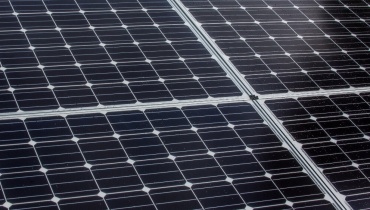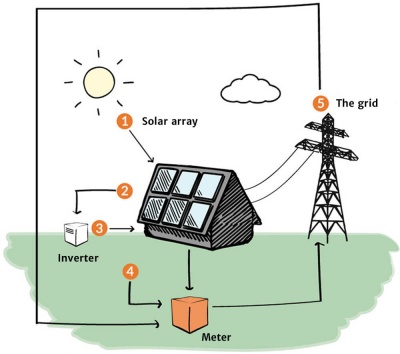Solar Energy
Shine On!
In a Flash

The Sun provides a renewable source of light and heat energy.
Solar Energy
Solar energy is energy provided by the Sun in the form of solar radiation. Every day the Sun radiates, or sends out, an enormous amount of energy. This Radiant energy has powered life on earth for millions of years and is one of the most important source of energy for life forms. Solar energy is a renewable resource and it is becoming increasingly common that this energy is converted and used as an alternative to fossil fuels. Many technologies can harvest it directly to produce solar electricity for use in homes and businesses globally.
Burning Questions
What is solar energy?
Solar energy is radiant light and heat from the Sun, and can be harnessed using a range of technologies such as solar heating, solar photovoltaic and solar thermal electricity. Solar energy is a renewable source of energy that is sustainable and totally inexhaustible, unlike fossil fuels that are finite.
Solar energy is used for heating water for domestic use, heating space in buildings and generating electrical energy.
It is considered an environmentally friendly source of energy because it comes directly from the Sun; it does not involve the burning of fossil fuels.
Solar radiant energy
Solar Radiant or light energy is produced in the Sun as a result of nuclear fusion reactions and is transmitted to the earth through space by electromagnetic radiation in quanta or packets of energy called photons. This light energy can be utilised by a process called photovoltaic, which produces electricity directly (Photo meaning light and voltaic relating to electricity). This process is being used more and more as the technology is developed and becomes more economic. It is used widely in solar powered calculators and other devices.
Solar thermal energy
Solar Thermal or heat energy is used widely in Australia for heating water for our domestic use in Solar Water heaters. This is an excellent and economic energy solution as, by using the Sun's heat for making our hot water, we cut down on the amount of fossil fuels needed tobe burnt to supply electricity to do the same thing. The technology is now developing which will use solar thermal energy to produce steam at high enough temperatures and pressures to drive steam turbines for electricity generations.
Harnessing Solar Energy
The strength of the solar energy available at any point on the earth depends, on the day of the year, the time of day, and the latitude of the collection point. The amount of energy collected can be further changed depending on the orientation and shape of the object doing the collection. Insolation is a measurement of the amount of solar energy that reaches the surface of the Earth.
The amount of insolation an area receives depends upon the Sun's angle, the amount of dust and water vapor in the air, and the amount of cloud cover. Less than half of the radiation energy we receive from the Sun makes it to the ground. The rest is absorbed by the atmosphere or reflected-back out into space.
The strength of solar radiation at the outer edge of the earth's atmosphere when the earth is taken to beat its average distance from the Sun is called the solar constant, the mean value of which is 1.37 106 ergs per sec per cm2, or about 2 calories per min per cm2.
Active Solar Energy
Active solar technologies use electrical or mechanical devices to actively convert solar energy into another form of energy, most often heat or electricity.
Active solar heating systems use a collector and a fluid that absorbs solar radiation. Fans or pumps circulate air or heat-absorbing liquids through collectors and then transfer the heated fluid directly to a room or to a heat storage system. Active water heating systems usually have a tank for storing solar heated water.
Passive Solar Energy
Passive solar technologies do not use any external devices. Instead, they take advantage of the local climate to heat structures during the winter, and reflect heat during the summer.
Passive solar space heating happens when the Sun shines through the windows of a building and warms the interior. Building designs that optimise passive solar heating usually have south-facing windows that allow the Sun to shine on solar heat-absorbing walls or floors during the winter. The solar energy heats the building by natural radiation and convection. Window overhangs or shades block the Sun from entering the windows during the summer to keep the building cool.
The Sun
The Sun is the star that dominates our solar system. The amount of energy emitted by the Sun as radiation is quite constant. This energy output is generated deep within the Sun. As a star, the Sun is made up of 71% hydrogen, 27% helium, and 2% other elements. At the center of the Sun the density is 150 times that of water and the temperature is almost 16,000,000 Kelvin, which causes the nuclei of individual hydrogen atoms to undergo nuclear fusion (in other words they join-together). The result of this is that two hydrogen nuclei combine to make one helium nucleus, and energy is released in the form of radiation. Vast numbers of fusions occur every second, generating energy beyond our imagination. The energy produced moves out towards the solar surface by radiation and then by convection through the turbulent mixing of gases on the Sun's surface.
The Sun has produced energy for many millions of years and will do so for many millions more. It is estimated that there is enough hydrogen still in the Sun's core to last another 4.5 billion years.
Solar energy, as we refer to it, is the solar radiation (light and heat) that reaches the earth. Every day the Sun radiates enormous amounts of heat and light energy. The planet and the atmosphere absorb some of this energy with the remainder being reflected-back out into space.
The heat energy we receive from the Sun through radiation is the energy that gives life to living things. It is also the immense source of energy that generates the planet's weather, creating wind and the planet's water cycle.

Solar energy is radiant light and heat from the Sun.
Solar Photovoltaic (PV)
Some materials are sensitive to the Sun's radiant or light energy and react in such a way that we can harness this "reaction" to produce electricity.
The Sun's light energy can be converted directly into electricity in a single process using Photovoltaic (PV) cells, otherwise known as solar cells. A PV cell is a thin plate of light sensitive material made primarily of silicon, the second most abundant element in the earth 's crust, and the same semiconductor material used for computers.
When the silicon is combined with one or more other materials, it exhibits unique electrical properties in the presence of sunlight. Electrons are agitated by the light and move through the silicon. This is known as the photovoltaic effect and results in direct current (DC) electricity.
Many PV cells are linked together to create a standard PV module, which in turn are linked together into a PV array. PV modules have no moving parts, are virtually maintenance-free although they should be kept clean and clear of shading, and have a working life of 20-30 years.
The PV array produces direct current (DC) electricity. An "inverter" is used to convert the DC to alternating current (AC), so the power is the same as normal grid power and can be used in household appliances. The inverter is a box of electronics, like a computer.
The Photovoltaic (PV) cell was discovered in the early 1950's by researchers examining the sensitivity of a silicon wafer to sunlight. By the late 1950s, PV's were used to power U.S. space satellites and this success generated commercial applications for PV technology. The simplest PV systems power small calculators and wrist watches used every day, while more complicated systems provide electricity to pump water, power communications equipment, and even provide electricity to our homes.

Large banks of solar cells maximise the amount of solar energy they can generate.

Solar panels convert the sunlight's photon energy into electricity.
How Does Solar Power Work?
- 1.The Sun's light is absorbed by the solar panels.
- 2.The silicon and conductors in the panel convert the light into Direct Current (DC) electricity, which then flows into the inverter.
- 3.The inverter converts the DC into Alternate Current (AC) electricity, which is used in your home.
- 4.Any additional electricity that's not used by your home goes via your home's meter into the mains power grid for others to use.
- 5.Electricity is drawn from the grid when you need more power than your solar energy system produces.
With a grid connected solar system, you are still connected to mains power; which supplies your home and school at night and other times when the solar panels aren't generating enough electricity.
Teacher's Toolkit
Take this to the classroom!
Curriculum ready content.